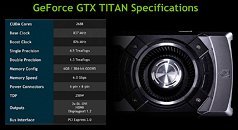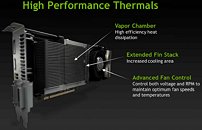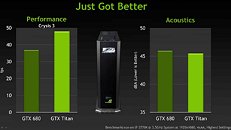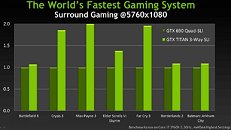Tuesday, February 19th 2013

NVIDIA GeForce GTX Titan Final Specifications, Internal Benchmarks Revealed
Specifications of NVIDIA's upcoming high-end graphics card, the GeForce GTX Titan, which were reported in the press over the last couple of weeks, are bang on target, according to a specs sheet leaked by 3DCenter.org, which is allegedly part of the card's press-deck. According to the specs sheet, the GTX Titan indeed features 2,688 out of the 2,880 CUDA cores present on the GK110 silicon, 6 GB of GDDR5 memory across a 384-bit wide memory interface, and draws power from a combination of 6-pin and 8-pin PCIe power connectors.
The GeForce GTX Titan core is clocked at 837 MHz, with a GPU Boost frequency of 876 MHz, and 6.00 GHz memory, churning out 288 GB/s of memory bandwidth. The chip features a single-precision floating-point performance figure of 4.5 TFLOP/s, and 1.3 TFLOP/s double-precision. Despite its hefty specs that include a 7.1 billion-transistor ASIC and 24 GDDR5 memory chips, NVIDIA rates the card's TDP at just 250W.More slides and benchmark figures follow.
The next slide leaked by the source reveals key features of the reference design cooling solution, which uses a large lateral blower that features RPM and voltage-based speed control on the software side, a vapor-chamber plate that draws heat from the GPU, memory, and VRM; and an extended aluminum fin stack that increases surface area of dissipation.Next up, we have performance numbers by NVIDIA. In the first slide, we see the GTX Titan pitted against the GTX 680, in Crysis 3. The GTX Titan is shown to deliver about 29 percent higher frame-rates, while being a tiny bit quieter than the GTX 680.
In the second slide, we see three GeForce GTX Titans (3-way SLI) pitted against a pair of GeForce GTX 690 dual-GPU cards (quad-SLI). In every test, the Titan trio is shown to be faster than GTX 690 Quad-SLI. In Crysis 3, GTX Titan 3-way SLI is shown to be about 75 percent faster; 100 percent faster in Max Payne 3, 40 percent faster in TESV: Skyrim, and 95 percent faster in Far Cry 3. Why this comparison matters for NVIDIA is that if Titan does end up being a $1000 product, NVIDIA will have to sell three of them while offering something significantly better than GTX 690 quad-SLI.
Source:
3DCenter.org
The GeForce GTX Titan core is clocked at 837 MHz, with a GPU Boost frequency of 876 MHz, and 6.00 GHz memory, churning out 288 GB/s of memory bandwidth. The chip features a single-precision floating-point performance figure of 4.5 TFLOP/s, and 1.3 TFLOP/s double-precision. Despite its hefty specs that include a 7.1 billion-transistor ASIC and 24 GDDR5 memory chips, NVIDIA rates the card's TDP at just 250W.More slides and benchmark figures follow.
The next slide leaked by the source reveals key features of the reference design cooling solution, which uses a large lateral blower that features RPM and voltage-based speed control on the software side, a vapor-chamber plate that draws heat from the GPU, memory, and VRM; and an extended aluminum fin stack that increases surface area of dissipation.Next up, we have performance numbers by NVIDIA. In the first slide, we see the GTX Titan pitted against the GTX 680, in Crysis 3. The GTX Titan is shown to deliver about 29 percent higher frame-rates, while being a tiny bit quieter than the GTX 680.
In the second slide, we see three GeForce GTX Titans (3-way SLI) pitted against a pair of GeForce GTX 690 dual-GPU cards (quad-SLI). In every test, the Titan trio is shown to be faster than GTX 690 Quad-SLI. In Crysis 3, GTX Titan 3-way SLI is shown to be about 75 percent faster; 100 percent faster in Max Payne 3, 40 percent faster in TESV: Skyrim, and 95 percent faster in Far Cry 3. Why this comparison matters for NVIDIA is that if Titan does end up being a $1000 product, NVIDIA will have to sell three of them while offering something significantly better than GTX 690 quad-SLI.




132 Comments on NVIDIA GeForce GTX Titan Final Specifications, Internal Benchmarks Revealed
<joke>I bet it involved sacrificing 12 units of world's most precious resource to some dark elder gods or something.</joke>
(BTW the world's most precious resource is: <!joke>hot legal-aged lolis with very unusual natural hair colors (this does happen, albeit due to a very rare mutation. There are at least a couple of hundred [alive] people with this mutation in the world right now, AFAIK)</!joke>)
The 690 was all dolled up. Crowbar, wooden box and foam support. Then it was in a beat up box.
$1K sure doesnt buy you what it used to 6months ago:laugh:
If thats a picture of the Titan die its a A1. :p
If nothing else, the GPU represents a pretty good effort on Nvidia's part. 50% larger than the Tahiti chip, with only 10% greater power usage, and 10% better transistor density (12.89 million/mm^2 vs 11.82 for Tahiti)- for what I assume is greater than a 10% performance gain in both gaming and compute.Same as Tesla K20/K20C/K20X. Nvidia silicon starts at A1.
Geforce GTX Titan - Nvidia-Karte im Unboxing Video...